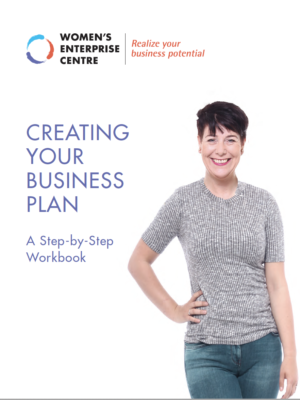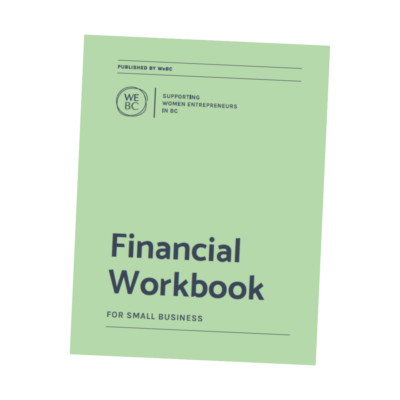Guide to Securing Business Loans for Women Entrepreneurs

Are you interested in applying for a business loan but aren’t sure where to start? Or are you looking for some tips to help improve your experience and increase the odds of having a successful loan application? If so, you’re in the right place!
At WeBC, we’ve provided business loans to women entrepreneurs since 1995, and we work with other lenders to help women get the financing they need to succeed. As a Business Advisor, I speak with women every day who are exploring their options. Here are some of my top tips for women who would like to access capital in BC.
1. Understand Your Lending Options in BC – Lenders 101
Let’s start at the very beginning by understanding what lending options are available to borrowers. You’re probably aware that there are a lot of different lenders, but who should you talk to first? Generally, I like to break down lenders into three categories.
Lending Option #1: Banks and Credit Unions
Banks and credit unions are sometimes known as ‘traditional lenders.’ These lenders will look at your credit score, personal financial history, and the financials of your business (among other things), and will compare those numbers against their lending guidelines to make a decision. This process is sometimes known as ‘formula lending.’ If you don’t meet their criteria, you are unlikely to be approved. Some banks and credit unions have special programs for equity-seeking groups, but there usually aren’t other demographic considerations. If you are in a good personal financial situation and have strong credit, a bank or credit union might be a good place for you to start your lending journey.
Lending Option #2: Developmental Lenders
Developmental lenders usually receive funding from the government to provide loans to small businesses as a way of supporting economic development. Developmental lenders in BC include:
- WeBC – For businesses owned and controlled by women
- Community Futures – For businesses in rural areas (i.e., not Vancouver or Victoria)
- Futurpreneur Canada – For folks under the age of 40 starting a new business
- Business Development Bank of Canada – Generally for established businesses, but they have many different programs
- Aboriginal Financial Institutions – For Indigenous-owned businesses
Developmental lenders work with a lot of small businesses who can’t secure the required financing through traditional lenders, so if you’re not having luck at your bank, a developmental lender should be your next stop. These lenders can often also offer additional supports to help you on your business journey. For example, at WeBC we have a mentoring program, a skills development program, and a business advising service that are all included as part of your loan care.
Lending Option #3: Alternative Lenders
Alternative lenders can vary from emergency lenders who will give a loan to almost anyone (for a price, of course), to industry-specific lenders who have created specialized loan products to meet specific requirements. Alternative lenders definitely play a role in the lending ecosystem, but I would generally advise entrepreneurs to approach with caution. Make sure you have a clear understanding of the payment terms and conditions, and if something seems too good to be true or comes with high pressure tactics, listen to your gut.If you have a woman-owned business in BC and aren’t sure where to start, WeBC is an excellent first stop. To learn more about lending program, you can check out our bi-weekly Business Loans Information Session (BLIS) webinar, which will provide more information and connect you with a Business Advisor who can help you start putting together your funding puzzle.
2. Understand if you are Eligible for a Business Loan
My next top tip for people who are seeking a business loan is to understand your eligibility with each business lender. As outlined above, there are a lot of different lenders out there, so your next step is to research the different lenders and what their criteria are. You can learn a lot from a lender’s website, but once you’ve determined your basic eligibility, you’re often going to have to connect with a real person to understand if a lending program is a good fit.
Common eligibility requirements include:
- Demographics, especially for developmental lenders. For example, to apply with WeBC your business must be majority owned and controlled by a woman, and to apply with Futurpreneur you must be under the age of 40.
- How long you have been operating for. For example, BDC will generally only lend to businesses that have been operating for more than a year, while Futurpreneur can only work with new businesses.
- Residency and citizenship, or operating in a specific geographic location, particularly for developmental lenders that are funded by the government.
- Minimum credit score. Some lenders will require you to have a minimum credit score to borrow from them, so it’s a good idea to pull your own credit report from one of the main credit reporting agencies in Canada (Equifax Canada or TransUnion) to check your score and make sure there are no errors on the report.
Minimum qualifying scores vary from lender to lender and often aren’t generally posted openly, but if your score is in the 700s or higher, you are probably in a strong position to get a loan. If your score is in the mid-600s or lower, you may find it more challenging. At WeBC, the only time we use a credit score cut off is for our unsecured Equal Access to Capital loans; we do not have a minimum credit score for our main loan program.
Another key eligibility consideration is security and equity – which leads me to my next tip:
3. Understand what security is, and how much you have available
Most people already have an idea of what security is—security is the lender’s claim on a borrower’s assets in case the borrower can’t repay their loan. Usually, specific assets (also known as collateral) are used as security. The lender will register these assets, and if you can’t repay your loan, the lender can sell the assets and keep the proceeds to recover some of the value of the loan. Lenders can often take business assets or personal assets as collateral.
Different lenders will have different security requirements. Some lenders want to be 100% secured, which means that you need to pledge assets to the loan that are worth the same amount that you are borrowing. At WeBC, we generally require you to pledge security that is worth at least 30% of the value of your loan, though there are exceptions.
So, before you talk to lenders, take a minute to think about what kind of assets you might be able to offer to secure the loan—do you have cash, a car, property, or equipment?
Remember, when a lender values your collateral, they will need to discount it. This means its value as collateral will be less than what you paid for it, and will be less than its current market value (sometimes by quite a lot). You should also keep in mind that lenders usually can’t take an asset for security if there is already a lien on it. So if you want to use a vehicle for security, you can’t still be paying it off—you need to own it free and clear.
4. Understand what equity is and how much you have contributed (or plan to contribute) to your business
The other eligibility concept to understand is equity. At its most basic, equity is the money that you invest into the business. This could be personal cash that you have invested over the years (share capital), or it could be profits that you have reinvested into the business over time (retained earnings). When you apply with a lender, they may ask how much equity you have available to contribute, or they may ask how much equity is currently in the business.
- If you have an existing business, looking at your balance sheet (if you have one) will be a good place to start to understand your equity position. If you don’t have a balance sheet, you may need to verify your equity investments another way.
- If you’re starting a new business, you’ll need to do some personal reflection to decide how much of your own money you are ready to contribute. And remember, a personal contribution should come from cash, not from taking out additional personal debt.
All lenders will be looking to see that you have some equity in the business. At WeBC, our guideline is you must contribute at least 25% of the value of your debt as equity (with an exception for our joint loan program with Futurpreneur). So if you are planning to take out $100,000 in total debt, you should be able to contribute at least $25,000 of your own money, or show that you have already invested that amount. If you don’t have any of your own money to contribute to your business, or if you have low or negative equity on your balance sheet, it may be difficult to secure a business loan.
5. Prepare a strong business plan
Your lender is going to need to know a lot about your business before they can make a lending decision, and the best way to communicate that information is with a business plan. Your business plan should lay out the fundamentals of your business, and should inform the reader about where you’re currently at in your business journey, where you are going, and what it will take to get there.
Check out our free guide, How to Write an Effective Business Plan for more details, but here are a few key questions to make sure you cover in your plan:
- What problem are you solving?
- Who is your target market?
- How have you established Proof of Concept? Or, in other words, how do you know that people actually want to buy what you are selling?
- How are you different from your competitors?
- Why are you the right person to operate this business?
- What do you need to execute your plan? (people, equipment, space, etc)
- What is your action plan?
- What are the main risks you may face, and how will you manage those risks?
How long should your business plan be? The answer, of course, is: it depends! The trick is to make sure that it includes all of the essential business planning information without going overboard with nonessential information. I have seen excellent business plans that are 10-15 pages, and 30 page plans that are still missing a lot of information. Try to review your plan with an eye towards taking out the ‘fluff’—your lenders will thank you!
Once your business plan is prepared, don’t forget to keep it alive! I recommend having a look at your business plan every few months to see if you’re still on track. If your plans change, take some time to update the business plan—this process may help you identify potential roadblocks or opportunities with your new path.

Creating Your Business Plan: A Step-by-Step Workbook
The Creating Your Business Plan Workbook is a comprehensive learning guide that takes you through each step of the business planning process—from thinking about starting a business to ticking off your business plan checklist.
6. Prepare a realistic cash flow projection
Along with your business plan, a cash flow projection is the other main way that you will tell your story to a lender. Cash flow projections are very important, so make sure you take the time to be thoughtful and thorough.
Your cash flow projection is a forward-looking estimate of how much revenue you think your business will earn, and what costs you will incur to earn that revenue. Your cash flow projection should also include all the one-off costs associated with starting or expanding a business, such as purchasing equipment or doing leasehold improvements.
Your lender will look at your sources of cash (revenue, loans, and personal contributions), against your uses of cash (expenses, asset purchases, etc.), to make sure you will have enough money to execute your plan.
A common challenge with cash flow projections is that people are often too optimistic. If your projections look too good to be true, your lender may not be confident in your estimates. My advice is to prepare at least two cash flow scenarios: one optimistic version that shows your revenues and expenses if everything goes well, and one pessimistic scenario that shows the business just breaking even. This provides the lender with valuable information.
You also need to be able to back up your revenue and expense estimates. If you are an existing business, you can use past financial data to get an idea of what your revenues and expenses will be in the future. If you’re a new business though, it can be more challenging – after all, you don’t have a crystal ball!
If you’re just starting up, operating expenses can often be verified by doing research and calling your service providers to get quotes. To estimate your Cost of Goods Sold, you can look at industry benchmarks to understand what a good Gross Margin is for your business and how that translates into Cost of Goods Sold.
Revenues can be a bit trickier to estimate, because no one really knows how much they will earn until they open their doors. However, there are techniques you can use to make an informed guess. For example, you can estimate how many customers you think you will have in a day, and how much you think they will spend per visit. That will get you an idea of your potential daily sales. Then you need to adjust daily sales to account for your busier days and slower days. You also need to consider any seasonal changes to your sales. For example, if you’re in the ice cream business, you might see sales pick up in the summer and slow down in the winter.

Financial Workbook for Small Business
This introductory-level guide takes you through practical exercises to help you understand the type of information financial statements provide.
7. Get your timing right
When you’re planning to apply for a business loan, it’s important to get the timing right. If you apply too early, your lender won’t have enough information to do a full assessment, but if you apply too late, you may find yourself running into trouble financially, or you might not be able to meet your own timelines.
A good rule of thumb is before you apply you should have some level of certainty about the main expenditures you will need to make. This means you should have quotes for equipment or major work that needs to be done, and, if you need a location for your business, you should have a specific place in mind, and should have already started talking to the landlord. Of course, you probably shouldn’t sign a binding lease or purchase order before you’ve been approved for the loan you need, but try to get as far along as you can without fully committing.
You should also make sure you understand your lender’s timelines. It can sometimes take a while (especially for developmental lenders) to make a lending decision, so it’s a good idea to work those timelines into your overall plan. Make sure you have enough time to commit to the process, because the faster you respond to your lender, the faster they can get back to you with a decision.
8. Get your ducks in a row
Lastly, applying for a loan can be a lot of work! In addition to preparing the business plan and cash flow projection, your lender will also ask you to gather and send all sorts of other documentation as well. The better organized you are when you apply, the better the experience will be for you and the lender (and it’s always a good idea to keep your lender happy!)
Here are a few things to get ready:
- If you’re an existing business, make sure you have your most recent year end financials ready to go. Also be prepared to send year-to-date statements showing your revenues and expenses from the date of your last financial statements up until the present.
- If you’re planning to make some big purchases with your loan funds, try to get detailed quotes. This is especially important if your project involves construction work; many clients can be surprised at the difference between the ‘ballpark’ estimate they put together and the detailed quote for how much it will actually cost.
- Make sure you’re available. Your lender will have lots of questions for you, so make sure you have the time to invest in the process.
Applying for a business loan can be a daunting process, but don’t let that scare you! Lenders are there to provide information and help you through the process.
And remember, you may need to talk to a few lenders to find the right fit for you—it’s all part of the process. Hopefully the tips in this blog will help you move through the process more smoothly.

Join one of our free Zoom sessions to learn about our loans program and how you may be able to access $150K to start, buy or grow your business.




